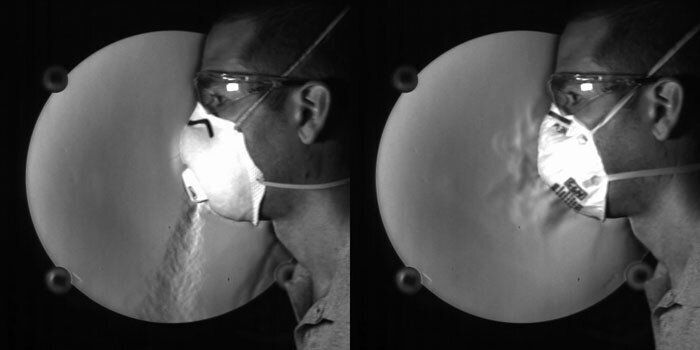For months, health experts have been warning against the use of valved masks in the UK – but they’re still sold in shops and pharmacies.
This might be about to change however, as the World Health Organisation (WHO) has updated its guidance on wearing face masks, stating: “Exhalation valves are discouraged because they bypass the filtration function of the fabric mask rendering it unserviceable for source control.”
Such masks are problematic because the valve part can act as an exhaust pipe for the wearer’s breath, propelling it into the surrounding air. And here lies the problem, because the whole point of wearing a mask is to protect those around you. But a valved mask essentially does the opposite.
Matthew Staymates, a mechanical engineer and fluid dynamicist at the National Institute of Standards and Technology, has been studying different mask types to determine which are the most effective at reducing disease transmission.
The exhalation valves on N95 masks are designed to improve user comfort by reducing filtration resistance during exhalation – making the mask more breathable. But this comfort may come at a high price if it harms other people’s health.
The valve is “basically a little flap that opens up when exhaling, which lets air out without being filtered through the mask material,” Staymates said. “I was able to visually show how this exhalation valve operates and compared it to an N95 that doesn’t have this valve.”

Staymates looked at the basic flow dynamics of N95 masks with or without exhalation valves, using schlieren imaging – which visualises fluid flow away from the surface of an object – and light scattering.
His research concluded that N95 masks with an exhalation valve are not appropriate masks for filtering out respiratory droplets, whereas N95 masks without valves are effective at blocking most droplets from penetrating through the mask material.

“Our current understanding is that Covid-19 is transmitted in part via respiratory droplets, so N95s with valves are not good for source control during this pandemic,” he said.
“My hope is that this work will help inform a large audience that valves on a mask are not helpful as we fight this global pandemic together.”
N95 masks are considered the crème de la crème of face masks, so if the valves on those aren’t particularly good at keeping a person’s germs in, it doesn’t hold much hope for any knock-off versions available on the high street.
Earlier on in the year, a video shared on the UK prime minister’s Twitter account came under fire for promoting the use of valved masks.
The animated video explained that mask-wearing would be made mandatory in England. Halfway through, an animated man was seen wearing a face mask which appeared to have a valve on it. The caption read: “By wearing a face covering, you are protecting others and slowing the spread of the virus.”
Not long after the chancellor of the exchequer, Rishi Sunak, was spotted wearing a valved mask in a public appearance, sparking criticism.
Professor Trisha Greenhalgh, an expert in primary care at University of Oxford, told HuffPost UK at the time that “some masks have a valve that isn’t as dangerous as most valves, but it’s still a very dumb thing for a politician to wear a valved mask because it gives the message that valved masks, in general, are a good thing.”
“They’re not,” she added, “they’re a bad thing.” So bad in fact that quite early on in the pandemic, masks with valves were banned in some US cities and counties.
A study published in the journal Infection Control and Hospital Epidemiology concluded that the use of masks with valves in the community “may be an additional and under-recognised transmission source” – and therefore they shouldn’t be used.
